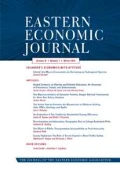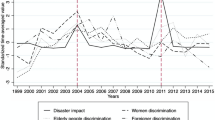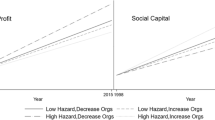Abstract
Federal disaster assistance should only compensate disaster victims for the damage sustained. Using zip code-level data on federal disaster assistance, this paper examines the FEMA Individuals and Households Program following Hurricane Sandy. We show that the extent of the damage does appear to explain much of the differences in the size of the federal disaster award that individuals receive. However, other factors, including percentage of foreign-born and the educational attainment levels of individuals in a community, also explain damage assessments and assistance levels. We argue that complexities in the application process may have disadvantaged foreign-born and less educated applicants.
Similar content being viewed by others
References
Beggs, John J., Haines, Valerie, and Hurlbert, Jeanne S. 1996. Situational Contingencies Surrounding The Receipt Of Informal Support. Social Forces, 75(1): 201–22.
Bertrand, Marianne, Sendhil Mullainathan, and Eldar Shafir. 2004. A Behavioral Economics View of Poverty. American Economic Review, 94(2): 419–423.
Bohnet, Iris, and Bruno S. Frey. 1999. Social Distance and Other-Regarding Behavior in Dictator Games: Comment. American Economic Review, 89(1): 335–9.
Bolin R.C., and Stanford L.M. 1993. Emergency Sheltering and Housing of Earthquake Victims: The Case of Santa Cruz County, in The Loma Prieta, California, Earthquake of October 17, 1989—Public Response, edited by P.A. Bolton, pp. B43–50. U.S. Geol. Surv. Prof. Pap. 1553B. Washington, DC: USGPO
Briggs, Xavier de Souza. 1998. Brown Kids in White Suburbs: Housing Mobility and the Many Faces of Social Capital. Housing Policy Debate, 9(1): 177–220.
Campbell, Karen E., Peter V. Marsden, and Jeanne S. Hurlbert. 1986. Social Resources and Socioeconomic Status. Social Networks, 8: 97–117.
Chamlee-Wright, Emily, and Virgil Henry Storr. 2009. Club goods and post-disaster community return. Rationality and Society 21(4): 429–458.
Craemer, Thomas. 2010. Evaluating Racial Disparities in Hurricane Katrina Relief Using Direct Trailer Counts in New Orleans and Fema Records. Public Administration Review, 70(3): 367–377.
Fothergill, Alice, and Lori Peek. 2004. Poverty and Disasters in the United States: A Review of Recent Sociological Findings. Natural Hazards, 32: 89–110.
Fothergill, Alice, JoAnne DeRouen Darlington, and Enrique G. M. Maestas. 1999. Race, Ethnicity, and Disasters in the United States: A Literature Review. Disasters, 23(2): 156–173.
Garrett, Thomas, and Russell Sobel. 2003. The political economy of FEMA disaster payments. Economic Inquiry, 41(3): 496–509.
Gladwin, Hugh, and Walter Gillis Peacock. 1997. Warning and Evacuation: A Night for Hard Houses, in Hurricane Andrew: Ethnicity, Gender and Sociology of Disasters, edited by Walter Gillis Peacock, Betty Hearn Morrow, and Hugh Gladwin. London: Routledge, 52–74.
Hoffman, Elizabeth, McCabe, Kevin, and Smith, Vernon L. 1996. Social Distance and Other Regarding Behavior in Dictator Games. American Economic Review, 86(3): 653–60.
Holzer, Harry J., John M. Quigley, and Steven Raphael. 2003. Public Transit and the Spatial Distribution of Minority Employment: Evidence from a Natural Experiment. Journal of Policy Analysis and Management, 22(3): 415–41.
Hooks, Jonathan, and Trisha Miller. 2006. The Continuing Storm: How Disaster Recovery Excludes Those Most in Need. California Western Law Review, 43(1): 21-73.
Ihlanfeldt, Keith R., and David L. Sjoquist. 1990. Job Accessibility and Racial Differences in Youth Employment Rates. The American Economic Review, 80(1): 267–276.
Leeson, Peter, and Russell Sobel. 2008. Weathering Corruption. Journal of Law and Economics, 51: 667–681.
Masozera, Michel, Melissa Bailey, and Charles Kerchner. 2007. Distribution of impacts of natural disasters across income groups: A case study of New Orleans. Ecological Economics, 63: 299–306.
Morrow, B.H. 1997. Stretching the Bonds: The Families of Andrew, in Hurricane Andrew: Ethnicity, Gender and the Sociology of Disaster, edited by Walter Gillis Peacock, Betty Hearn Morrow, and Hugh Gladwin. London: Routledge, 141–170.
O’Regan, Katherine M., and John M. Quigley. 1999. Spatial Isolation and Welfare Recipients: What Do We Know? Berkeley Program on Housing and Urban Policy Available online at http://escholarship.org/uc/item/1mz642ft.pdf.
Shughart, William F. 2006. “Katrinanomics: The Politics and Economics of Disaster Relief. Public Choice, 127(1–2): 31–53.
Smith, Sandra S. 2000. Mobilizing Social Resources: Race, Ethnic, and Gender Differences in Social Capital and Persisting Wage Inequalities. The Sociological Quarterly, 41(4): 509–537.
Sobel, Russell, Christopher Coyne, and Peter Leeson. 2007. The Political Economy of FEMA: Did Reorganization Matter? Journal of Public Finance and Public Choice, 17(2–3): 49–65.
Sobel, Russell, and Peter Leeson. 2006. Government’s Response to Hurricane Katrina: A Public Choice Analysis. Public Choice, 127: 55–73.
Subervi-Velez, F.A., Denney, M, Ozuna, A, Quintero, C, and Palerm, J. 1992. Communicating with California’s Spanish-speaking populations during emergencies. California Policy Seminar Brief, 4(12).
Author information
Authors and Affiliations
Corresponding author
Rights and permissions
About this article
Cite this article
Grube, L.E., Fike, R. & Storr, V.H. Navigating Disaster: An Empirical Study of Federal Assistance Following Hurricane Sandy. Eastern Econ J 44, 576–593 (2018). https://doi.org/10.1057/s41302-017-0098-x
Published:
Issue Date:
DOI: https://doi.org/10.1057/s41302-017-0098-x




